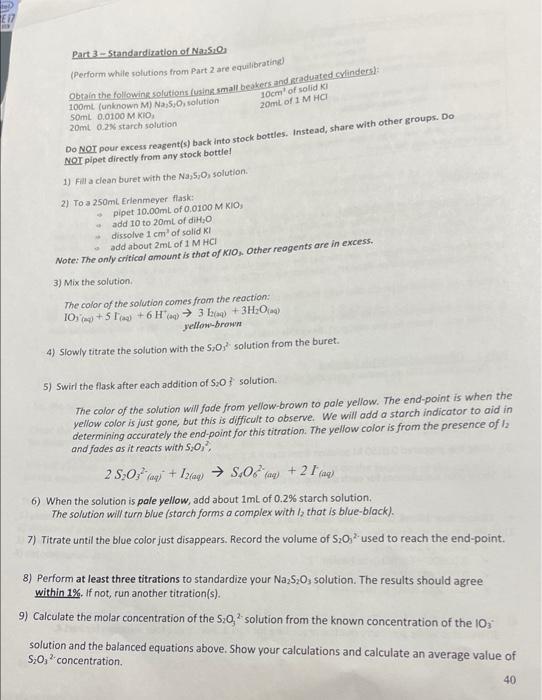Answered step by step
Verified Expert Solution
Question
1 Approved Answer
help to fill in the chart Specific Safety Procedures Calcium nitrate Hydrochloric acid Potassium iodate Complete SDS (Safety Data Sheet) for these chemicals are located
help to fill in the chart 


Specific Safety Procedures Calcium nitrate Hydrochloric acid Potassium iodate Complete SDS (Safety Data Sheet) for these chemicals are located in Wiegand in Precautions. Must wear chemical splasti proof safety roedes Indirect vent). Wach Hands thoroughly after reagents Waste Disposal lodate and iodide wastes go in the inorganic halogenated waste container. Do not dispone of lodete iodide wastes down the drain Potlodio Sodium sulfate PROCEDURE Part 1 - Preparation of Solid Ca(O Using graduate cylinders, obtain 20.0mL of 1.40 M Ca(NO:) and 70.0mL of 0.234 M KIO, and place each solution in separate beakers. 1) Pour the solutions together and stir. Let the solution stand for 10 minutes and then filter the precipitate using suction filtration. Your instructor will demonstrate 2) Wash any remaining precipitate onto the filter paper with the supernatant. 3) Wash the precipitate on the filter paper with four 10mL portions of diH,0. Allow to dry under suction while you prepare for the next part. Keep this solid for Part 2. Part 2 - Dilution of Ca(NO.) Solution Obtain three 250 ml beakers and label each beaker with the appropriate concentration 1) Using the 1.40 M Ca(NO3)2 solution, prepare 100.0mL of 0.100 M Ca(NO3)2 2) Using the prepared 0.100 M solution from step # 1, prepare 100.0 mL of 0.0250 M Ca(NO 3) Using the prepared 0.0250 M solution from step #2, prepare 100.0 mL of 0.00600 M CalNO). 4) Show your calculations for each dilution on the data sheet. Obtain four 100ml beakers and label them 1 thru 4. 1) Using a graduated cylinder, add 40.0mL of; diH2O to beaker "1" 0.00600M Ca(NO3h to beaker "2" 0.0250M Ca(NO3)2 to beaker "3" 0.100M Ca(NO3)2) to beaker "4" 2) Into each beaker from step # 1, add about % of the solid formed from Part 1 and allow to stand for 30 minutes while you carry out the procedure for Part 3. Save these four solutions for Part 4 Part 3 - Standardization of Naso (Perform while solutions from Part 2 are equilibrating obtain the following solutions (using small beakers and graduated sylinders 10cm of solid 20ml of 1 M HC 100ml (unknown M) Na 5.0, solution Soml 0.0100 M KIO 20ml 0.2% starch solution DO AQT pour excess reagent(s) back into stock bottles. Instead, share with other groups. Do NOT pipet directly from any stock bottle! 1) Fill a clean buret with the Na 5,0, solution 2) To a 250ml Erlenmeyer flask: pipet 10.00mL of 0.0100 M KIO add 10 to 20mL of diH dissolve 1 cm of solid KI add about 2mL of 1 M HCI Note: The only critical amount is that of KIO, Other reagents are in excess. 3) Mix the solution The color of the solution comes from the reaction 10+51 +6 H 3 ) +3H30/9) yellow-brown 4) Slowly titrate the solution with the SO2 solution from the buret. 5) Swirl the flask after each addition of S:0 ? solution. The color of the solution will fode from yellow-brown to pale yellow. The end-point is when the yellow color is just gone, but this is difficult to observe. We will add a starch indicator to aid in determining accurately the end point for this titration. The yellow color is from the presence of 12 and fades as it reacts with so fag) + 2 I fag) 2 S 0; ' + Izkap) 5.0 6) When the solution is pale yellow, add about Iml of 0.2% starch solution. The solution will turn blue (starch forms a complex with ly that is blue-black). 7) Titrate until the blue color just disappears. Record the volume of 5.0, used to reach the end-point. 8) Perform at least three titrations to standardize your NazS30solution. The results should agree within 1%. If not, run another titration(s). 9) Calculate the molar concentration of the 5:0, solution from the known concentration of the 10, solution and the balanced equations above. Show your calculations and calculate an average value of S;O, concentration 40 Titration Data Part (3) - Standardization of 5:03 0.0100M KIO3 Concentration of KIO, used 5 4 3 Titration # 2 mL KIO Initial buret Reading (ml) 10mL 10mL 10ml Oml 14.2mL 27.7mL Reading (mL) $14,2m2 27.7ml 421.05mL Tratado o 142mL 3.5 mL 13.35mL olm * V10, X6 (ottt) EteenLX60) Ns203-(buret) 142 Added (mL) S:0,2 (M) 10 3th C703 CSO3 Average Molarity of S 0,2 M 


Step by Step Solution
There are 3 Steps involved in it
Step: 1

Get Instant Access to Expert-Tailored Solutions
See step-by-step solutions with expert insights and AI powered tools for academic success
Step: 2

Step: 3

Ace Your Homework with AI
Get the answers you need in no time with our AI-driven, step-by-step assistance
Get Started


